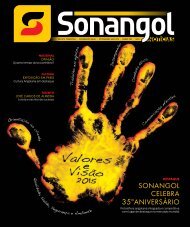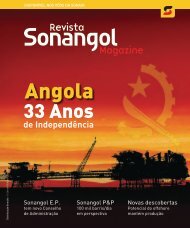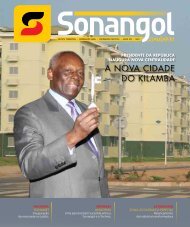PDF Format - Sonangol Limited - Oil Trading Services
PDF Format - Sonangol Limited - Oil Trading Services
PDF Format - Sonangol Limited - Oil Trading Services
You also want an ePaper? Increase the reach of your titles
YUMPU automatically turns print PDFs into web optimized ePapers that Google loves.
ENVIRONMENT<br />
The Kavango-Zambezi Transfrontier<br />
Conservation Area<br />
(Kaza) is an extraordinary<br />
intergovernmental effort to<br />
create a wildlife park across huge swathes<br />
of land where Angola, Botswana, Namibia,<br />
Zambia and Zimbabwe converge.<br />
The aim is to protect the biodiversity<br />
and culture in this corner of southern<br />
Africa without regard to borders.<br />
Angola owns the second-biggest slice<br />
of the proposed protected area, which at<br />
444,000sq km is the size of Sweden. Kaza is<br />
named after the two largest river systems<br />
that drain the region, the Okavango<br />
and Zambezi. The area is home to the<br />
world’s biggest elephant population and a<br />
wealth of other endangered plant and<br />
animal species.<br />
The project is not only about the welfare<br />
of the flora and fauna. Kaza member<br />
countries are expecting an explosion of<br />
tourism in the area, which will hopefully<br />
boost socio-economic development and<br />
conserve local cultures.<br />
Angola is responsible for the second-<br />
largest section of the area, some<br />
90,000sq km. This covers the Luiana Partial<br />
Reserve, the Mavinga Partial Reserve, and<br />
the Longa-Mavinga, Luengue, Luiana and<br />
Mucusso hunting areas.<br />
Kuando Kubango province forms the<br />
project’s starting point in Angola. From<br />
there, it crosses the border to Botswana<br />
and continues towards Botswana’s<br />
Okavango Delta.<br />
“The vast wilderness of Angola’s Luiana<br />
and Luenge national parks and adjacent<br />
areas with near-pristine wildlife habitats<br />
offers unexploited tourism development<br />
potential,” Kaza director Dr Victor<br />
Siamudaala told Universo when asked to<br />
name Angola’s most vital contribution to<br />
the project, adding that “Angola’s unique<br />
culture and cuisine, too, are particularly<br />
attractive to tourists.”<br />
Official birth<br />
The first steps of the Kaza project date<br />
back to the 1990s, with the establishment<br />
of the Okavango Upper Zambezi Tourism<br />
Initiative funded through the South African<br />
Development Community. The project<br />
failed to take off and was succeeded by<br />
others, until the foundation stone of the<br />
current Kaza scheme was laid in December<br />
2006 when the five member countries<br />
signed a memorandum of understanding.<br />
Its formal establishment took place in<br />
August 2011 when the leaders of Angola,<br />
Botswana, Namibia, Zambia and Zimbabwe<br />
signed the Kaza Treaty in Luanda, at the<br />
closing ceremony of the 31st SADC (Southern<br />
African Development Community) Summit.<br />
“For five countries to come together<br />
and decide to mutually conserve<br />
their natural resources in a<br />
sustainable way and benefit local<br />
communities and eventually reduce<br />
rural poverty is truly admirable”<br />
– Dr Victor Siamudaala<br />
Kaza was officially launched in March<br />
2012 at the Namibian town of Katima<br />
Mulilo. The project is jointly administered<br />
by the governments of the five partner<br />
countries and is supported by various<br />
international donors. The co-ordinating<br />
role of Kaza rotates biannually between<br />
the five nations.<br />
“For five countries to come together<br />
and decide to mutually conserve their<br />
natural resources in a sustainable way and<br />
benefit local communities and eventually<br />
reduce rural poverty is truly admirable,”<br />
said Dr Siamudaala.<br />
Elephants<br />
One of the most spectacular aspects of<br />
the Kaza project is that it will harbour<br />
the largest contiguous population of the<br />
African elephant (around 250,000) on the<br />
continent. Southern Africa’s elephants<br />
face two important issues: poaching –<br />
they are much sought after for their ivory<br />
– and overpopulation in areas where they<br />
infringe on farmland.<br />
Botswana drew up a plan in 1990, which<br />
put the maximum number of elephants<br />
the country could handle at 60,000. But<br />
because culling was controversial and<br />
Botswana wanted to avoid international<br />
condemnation, it allowed numbers to grow.<br />
There are now some 150,000 elephants<br />
in Botswana, which are in dire need of<br />
an alternative habitat. Zambia, and in<br />
particular the Angolan province of Kuando<br />
Kubango, offer a way of diluting these<br />
populations through Kaza ‘transfrontier<br />
corridors’ or protected tracts of land.<br />
Angola’s 199,049sq km Kuando<br />
Kubango province will make up a major<br />
portion of the reserve. After four decades<br />
of independence and civil war, which<br />
ended in 2002, it had only around 140,000<br />
people living there. The conflict took a<br />
heavy toll on the province’s wildlife, as<br />
elephant ivory was sold to buy weapons<br />
and other wild animals served as food<br />
for soldiers and farmers. Now Kaza offers<br />
Kuando Kubango a promising new future.<br />
With its continuing landmine clearance<br />
campaigns, the province could provide a<br />
vast new home for Botswana’s superfluous<br />
elephant population.<br />
34 SONANGOL UNIVERSO DECEMBER 2012 35<br />
Mark Clydesdale BZO<br />
Simon Greig<br />
wollemipine<br />
Eland antelope, a native of the Okavango region








